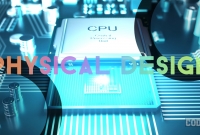
FABRICATION
CHIP FABRICATION
Fabrication
FABRICATION
By the GDS II file information we fabricate the chip. The total design is converted into chip by the manufacturing process.
CHIP MANUFACTURING PROCESS
Integrated Circuit (IC)
An Integrated Circuit (IC) is also called as chip or microchip. It is a semiconductor wafer in which millions of components are fabricated. The active and passive components such as resistors, diodes, transistors etc and external connections are usually fabricated in on extremely tiny single chip of silicon. All circuit components and interconnections are formed on single thin wafer (substrate) is called monolithic IC. IC is very small in size. It require microscope to see connections between components why because all are very tiny in size. The process of steps to fabrication of an Integrated chips is similar to the steps required to fabricate transistors, diodes etc. In IC chips, the fabrication of circuit elements such as transistors, diodes, capacitors etc. and their interconnections are done at same time.
Following are the advantages of an IC such as
extremely small size,
small weight,
low cost,
low power consumption, .
high processing speed,
easy replacement, etc.
IC is the principal component in all electronic devices.
IC can function as
amplifier,
oscillator,
timer,
counter,
computer memory etc.
IC fabrication Process
IC MANUFACTURING PROCESS
The manufacturing of Integrated Circuits (IC) consists of following steps. The steps includes 8-20 patterned layers created into the substrate to form the complete integrated circuit. The electrically active regions are created due to this layering in and on the surface of wafer. Hundreds of integrated circuits can be made on a single thin silicon. Then it is cut into individual IC chips.
Wafer production
The first step is wafer production. The wafer is a round slice of semiconductor material such as silicon. Silicon is preferred due to its characteristics. It is more suitable for manufacturing IC. It is the base or substrate for entire chip. First purified polycrystalline silicon is created from the sand. Then it is heated to produce molten liquid. A small piece of solid silicon is dipped on the molten liquid. Then the solid silicon (seed) is slowly pulled from the melt. The liquid cools to form single crystal ingot. A thin round wafer of silicon is cut using wafer slicer. Wafer slicer is a precise cutting machine and each slice having thickness about .01 to .025inches. When wafer is sliced, the surface will be damaged. It can be smoothening by polishing. After polishing the wafer, it must thoroughly clean and dried. The wafers are cleaned using high purity low particle chemicals .The silicon wafers are exposed to ultra pure oxygen.
Epitaxial growth
It means the growing of single silicon crystal upon original silicon substrate. A uniform layer of silicon dioxide is formed on the surface of wafer.
Masking
To protect some area of wafer when working on another area, a process called photolithography is used. The process of photolithography includes masking with a photographic mask and photo etching. A photoresist film is applied on the wafer. The wafer is aligned to a mask using photo aligner. Then it is exposed to ultraviolet light through mask. Before that the wafer must be aligned with the mask. Generally, there are automatic tools for alignment purpose.
Etching
It removes material selectively from the surface of wafer to create patterns. The pattern is defined by etching mask. The parts of material are protected by this etching mask. Either wet (chemical) or dry (physical) etching can be used to remove the unmasked material. To perform etching in all directions at same time, isotropic etching will be used. Anisotropic etching is faster in one direction. Wet etching is isotropic, but the etching time control is difficult. Wet etching uses liquid solvents for removing materials. It is not suited to transfer pattern with submicron feature size. It does not damage the material. Dry etching uses gases to remove materials. It is strongly anisotropic. But it is less selective. It is suited to transfer pattern having small size. The remaining photo resist is finally removed using additional chemicals or plasma. Then the wafer is inspected to make sure that the image is transferred from mask to the top layer of wafer.
Doping
To alter the electrical character of silicon, atom with one less electron than silicon such as boron and atom with one electron greater then silicon such as phosphorous are introduced into the area. The P-type (boron) and N-type (phosphorous) are created to reflect their conducting characteristics. Diffusion is defined as the movement of impurity atoms in semiconductor material at high temperature.
Atomic diffusion
In this method p and n regions are created by adding dopants into the wafer. The wafers are placed in an oven which is made up of quartz and it is surrounded with heating elements. Then the wafers are heated at a temperature of about 1500-2200°F. The inert gas carries the dopant chemical. The dopant and gas is passed through the wafers and finally the dopant will get deposited on the wafer. This method can only be used for large areas. For small areas it will be difficult and it may not be accurate.
Ion implantation
This is also a method used for adding dopants. In this method, dopant gas such as phosphine or boron trichloride will be ionized first. Then it provides a beam of high energy dopant ions to the specified regions of wafer. It will penetrate the wafer. The depth of the penetration depends on the energy of the beam. By altering the beam energy, it is possible to control the depth of penetration of dopants into the wafer. The beam current and time of exposure is used to control the amount of dopant. This method is slower than atomic diffusion process. It does not require masking and this process is very precise. First it points the wafer that where it is needed and shoot the dopants to the place where it is required.
Metallization
It is used to create contact with silicon and to make interconnections on chip. A thin layer of aluminum is deposited over the whole wafer. Aluminium is selected because it is a good conductor, has good mechanical bond with silicon, forms low resistance contact and it can be applied and patterned with single deposition and etching process.
Making successive layers: - The process such as masking, etching, doping will be repeated for each successive layers until all integrated chips are completed. Between the components, silicon dioxide is used as insulator. This process is called chemical vapor deposition. To make contact pads, aluminum is deposited. The fabrication includes more than three layers separated by dielectric layers. For electrical and physical isolation a layer of solid dielectric is surrounded in each component which provides isolation. It is possible to fabricate PNP and NPN transistor in the same silicon substrate. To avoid damage and contamination of circuit, final dielectric layer (passivation) is deposited. After that, the individual IC will be tested for electrical function. Check the functionality of each chip on wafer. Those chips are not passed in the test will be rejected.
Assembly and packaging
Each of the wafers contains hundreds of chips. These chips are separated and packaged by a method called scribing and cleaving. The wafer is similar to a piece of glass. A diamond saw cut the wafer into single chips. The diamond tipped tool is used to cut the lines through the rectangular grid which separates the individual chips. The chips that are failed in electrical test are discarded. Before packaging, remaining chips are observed under microscope. The good chip is then mounted into a package. Thin wire is connected using ultrasonic bonding. It is then encapsulated for protection. Before delivered to customer, the chip is tested again. There are three configurations available for packaging. They are metal can package, ceramic flat package and dual in line package. For military applications, the chip is assembled in ceramic packages. The complete integrated circuits are sealed in anti static plastic bags.









